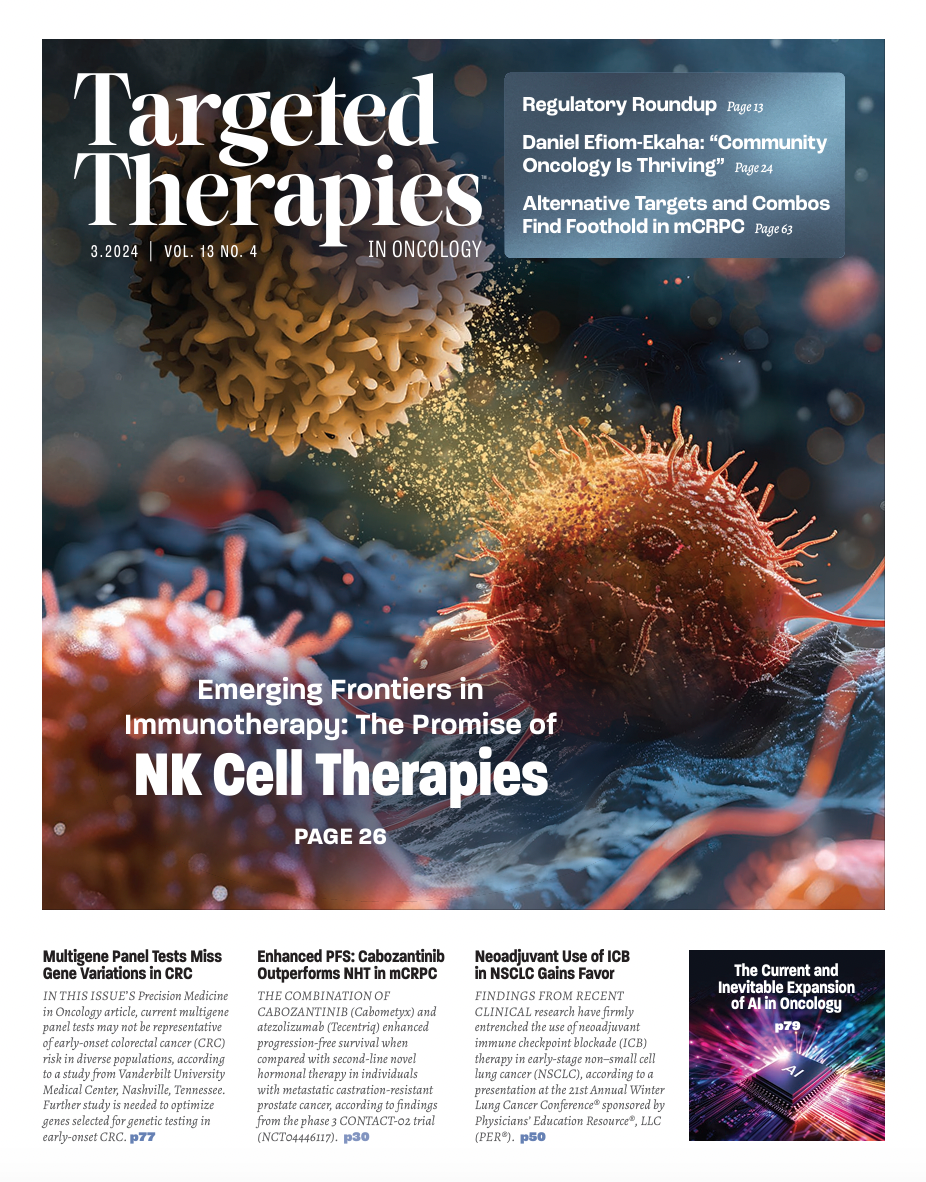Optimizing Biomarker Testing in Early-Stage Disease for Patients With NSCLC
Recommendations for non–small cell lung cancer biomarker testing in early-stage disease were discussed in a presentation regarding metastatic lung cancer by Christine M. Lovly, MD, PhD.

Biomarker testing in early-stage non-small cell lung cancer (NSCLC) and its importance in sequencing treatment was explored in a presentation by Christine M. Lovly, MD, PhD, at the 21st Annual Winter Lung Cancer Conference in Hollywood, Florida, sponsored by Physicians’ Education Resource, LLC (PER). Lovly also addressed differences between squamous and nonsquamous NSCLC biomarker testing.1
“What do we need to test for in 2024? There are 10 biomarkers with FDA-approved genotype-directed targeted therapies: ALK fusions, BRAF V600E, EGFR exon 20 insertions, HER2, KRAS G12C, MET exon 14 skipping, and others. It is important to remember that these are not binary [present or absent]," Lovly the Ingram Associate Professor of Cancer Research and associate professor of medicine in the Division of Hematology-Oncology at the Vanderbilt-Ingram Cancer Center at Vanderbilt School of Medicine in Nashville, Tennessee, said.1
Referencing the National Comprehensive Cancer Network (NCCN) guidelines, Lovly addressed the difference in recommendations for squamous and nonsquamous NSCLC. “If we examine nonsquamous NSCLC in the metastatic setting, there is a category 1 recommendation of testing for driver oncogenes. These are listed alongside FDA-approved targeted therapies, highlighting the importance of broad molecular testing,” Lovly said. Rather than focusing solely on individual mutations such as EGFR or ALK, the emphasis is on comprehensive profiling.
Additionally, PD-L1 testing is also considered category 1. Although the NCCN states that molecular testing for squamous cell carcinoma should be considered but is not required, it leaves room for exploration in this domain, despite its primary association with nonsquamous disease populations.2 For small cell lung cancer, the NCCN also recommends considering molecular testing, Lovly highlighted.
Illustration of DNA strands

Regarding early-stage disease, Lovly pointed out that the current practice is to test for EGFR mutations during this stage because there is a category 1 recommendation for using osimertinib (Tagrisso) in the adjuvant setting for stages IB and IIIA. This is based on data from the phase 3, double-blind ADAURA trial (NCT02511106), which evaluated the use of osimertinib vs placebo in patients with NSCLC stages IB to IIIA.
Investigators reported that the median follow-up was 44.2 months in the treatment arm vs 19.6 months in the placebo arm and the 4-year disease-free survival (DFS) rate was 70% in the treatment arm and 29% in the placebo arm.3
In the adjuvant setting, based on findings from the phase 3 ALINA trial (NCT03456076), it is recommended to test for the ALK mutation. In the study, patients with ALK mutation plus early-stage NSCLC were randomly assigned to receive alectinib (Alecensa) or chemotherapy, with baseline characteristics well balanced between arms. DFS was significantly improved using alectinib compared with chemotherapy (HR, 0.22; 95% CI, 0.08-0.58), although overall survival (OS) data were immature. Alectinib was administered for up to 24 months until unacceptable toxicity, withdrawal from the trial, or disease progression.4 Lovly mentioned testing for PD-L1 in early-stage disease to provide an overall comprehensive approach is also recommended, according to NCCN guidelines.
Although it is a “rapidly evolving topic,” Lovly noted that in the neoadjuvant setting, it is recommended to test for the EGFR and ALK mutations and PD-L1 expressions. This recommendation is based on findings from the phase 3 KEYNOTE-671 trial (NCT03425643), which evaluated patients with resectable stage II, IIIA, and IIIB NSCLC receiving neoadjuvant pembrolizumab (Keytruda) for 4 cycles plus chemotherapy followed by adjuvant pembrolizumab vs placebo plus chemotherapy alone for up to 13 cycles. Study investigators reported an event-free survival improvement at 24 months in the treatment arm (62.4%) vs 40.6% in the placebo arm (HR for progression, recurrence, or death, 0.58; CI 95%, 0.46 - 0.72; P <.001). The estimated 24-month OS rates were 80.9% vs 77.6%.5
Regarding the optimal sequence for testing, Lovly addressed a divergence between sequence testing using liquid biopsy and tissue biopsy for an EGFR mutation. If an EGFR mutation is found using liquid biopsy, a tissue biopsy is not needed, Lovly stated. She would then proceed with EGFR tyrosine kinase inhibitor therapy. However, if the liquid biopsy [result] is negative, then a tissue biopsy is needed. “This is a very important point: You cannot stop at liquid if the liquid [test result] is negative,” Lovly emphasized. This point is supported by the International Association for the Study of Lung Cancer guidelines.6
“In the ideal case, you get the testing and initial diagnosis, you use it to grow your treatment selection, [and] you use it to help guide enrollment into clinical trials. This is so important. We cannot continue to advance new drugs unless we have this biomarker information,” Lovly said.
REFERENCES:
1. Lovly C. Biomarker testing in metastatic lung cancer. Presented at: 21st Annual Winter Lung Cancer Conference; February 2-4, 2024; Hollywood, FL.
2. NCCN. Clinical Practice Guidelines in Oncology. Non-small cell lung cancer, version 5.2023. Accessed February 25, 2024. https://www.nccn.org/professionals/physician_gls/pdf/nscl_blocks.pdf
3. Herbst RS, Wu YL, John T, et al. Adjuvant osimertinib for resected EGFR-mutated stage IB-IIIA non-small-cell lung cancer: updated results from the phase III randomized ADAURA trial. J Clin Oncol. 2023;41(10):1830-1840. doi:10.1200/JCO.22.02186
4. Solomon BJ, Ahn JS, Dziadziuszko R, et al. LBA2 ALINA: efficacy and safety of adjuvant alectinib versus chemotherapy in patients with early-stage ALK+ non-small cell lung cancer (NSCLC). Ann Oncol. 2023;34(suppl 2):S1295-S1296. doi:10.1016/j.annonc.2023.10.051
5. Wakelee H, Liberman M, Kato T, et al. Perioperative pembrolizumab for early-stage non-small-cell lung cancer. N Engl J Med. 2023;389(6):491-503. doi:10.1056/NEJMoa2302983
6. IASLC atlas of molecular testing for targeted therapy in lung cancer. International Association for the Study of Lung Cancer. Updated 2023. Accessed February 13, 2024. https://tinyurl.com/4cuxxs9x

Survivorship Care Promotes Evidence-Based Approaches for Quality of Life and Beyond
March 21st 2025Frank J. Penedo, PhD, explains the challenges of survivorship care for patients with cancer and how he implements programs to support patients’ emotional, physical, and practical needs.
Read More